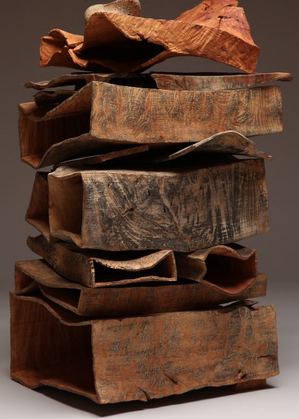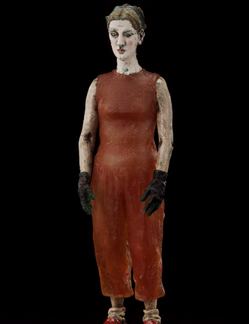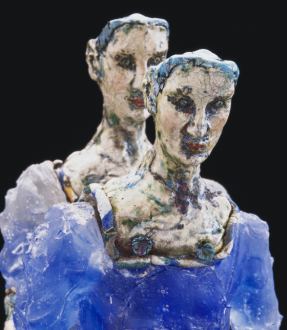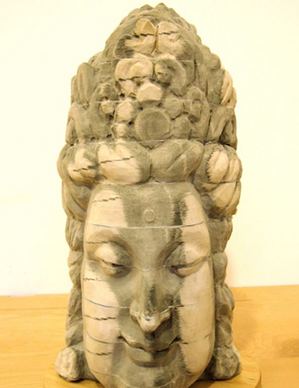(Three exhibits at the Bellevue Arts Museum., all organized by the museum. Click images to enlarge.)
1. Lopez Island wood carver Michael Peterson begins with chunks of green fir, hemlock, cedar or madrone. He needs it to be wet, almost pulpy, so he can hollow it out with a chainsaw and shape the edges. As the piece dries, it shrinks and pulls, extending the marks of the chain into long gullies that the artist smooths by sandblasting and sometimes bleaching.
 The natural world is putty in his hands, and the force he brings to bear is a kind of erosion. When he presents them in layers, each is free, with nothing rooted or glued down.
The natural world is putty in his hands, and the force he brings to bear is a kind of erosion. When he presents them in layers, each is free, with nothing rooted or glued down.
To September 20. Peterson is represented by the Traver Gallery.
2. Portland’s Judy Hill is an artist who dares to repeat herself. For decades she has fashioned the same figures in colored glass and raku, which is not, in contemporary art, thought to be a good thing. For her, it is.
 The glass looks like previously-licked lollipops, overheated and on the verge of melting. The clay is corrosive, grizzled and seamed. Her women have been through a lot, but their
The glass looks like previously-licked lollipops, overheated and on the verge of melting. The clay is corrosive, grizzled and seamed. Her women have been through a lot, but their
confectionery, free-floating attire makes it impossible to sum them up or write them off.
 Through January 3.
Through January 3.
3.The Book Borrowers: Contemporary Artists Transforming the Book : Using the Edward Ruscha rule, if Michael Peterson’s work is huh? wow!, then the artists in this show tend toward wow! huh.
Peter Schjeldahl explains:
Start anywhere. Look. Wonder why any given art is the way it is and not some other way. The artist made certain choices, producing certain effects. Walk back the cat, as they say in espionage. Perhaps read art historians and critics for clues–but not solutions. Your own pleasure must be your goal and guide. A great deal of art, of any period, is ridiculous. But you won’t be a fair judge unless you consent to regard each work as sincere and intelligent until proven otherwise. (Developing taste speeds up the process, but it’s still a process.) If you hate a work on first sight, fine. That’s an authentic response. But stick around. Keep looking. You will have further responses. You might end up hating the work even more, but with an enriched understanding of both it and yourself. Very often, our judgment evolves the other way: what we think we like, at first, disappoints upon contemplation. The artist Edward Ruscha promulgated a handy rule in this regard: “Bad art is ‘Wow! Huh?’ Good art is ‘Huh? Wow!’
About the Book Borrowers, I wouldn’t go so far as to say bad. No rule, no matter how catchy, works outside its own inevitability narrow framework. But thanks to their material invention, these artists have an immediate appeal, although there’s little in the way of a second punch.
That said, I’m extremely fond of Long-Bin Chen’s Guan Ying with Flower Crown (Ming Dynasty), 2007, carved from Manhattan white pages phone books. I do not believe that custom would stale its variety. Years from now, if I happen upon it, I’ll say, “From phone books. Wow.”




Leave a Reply